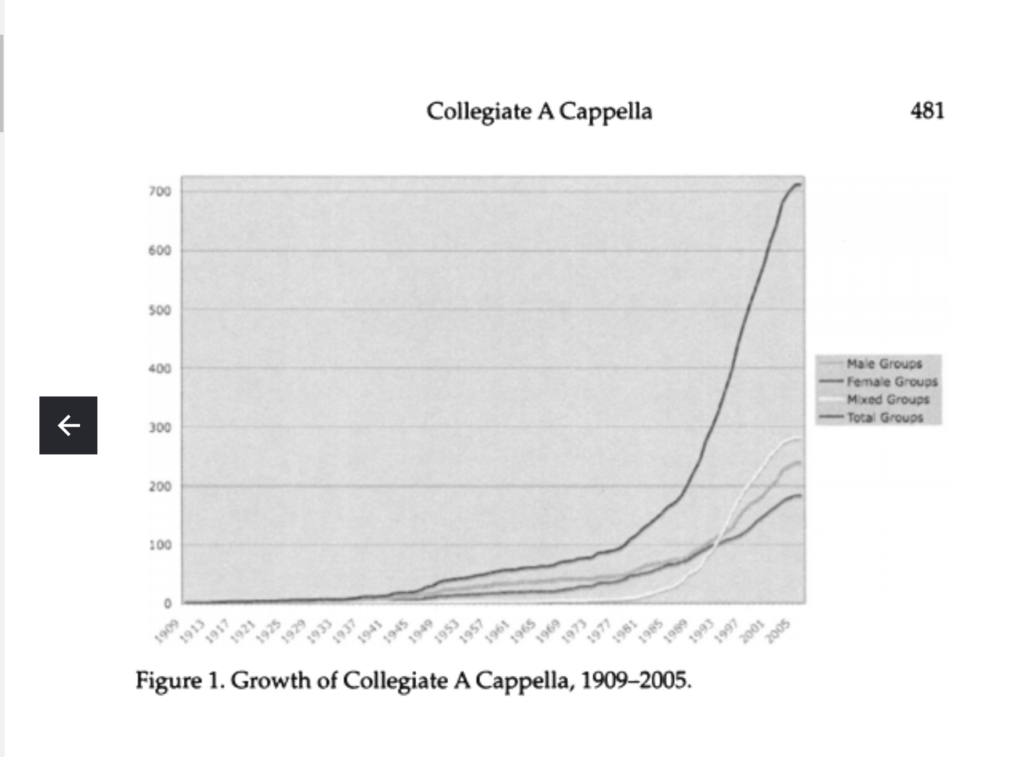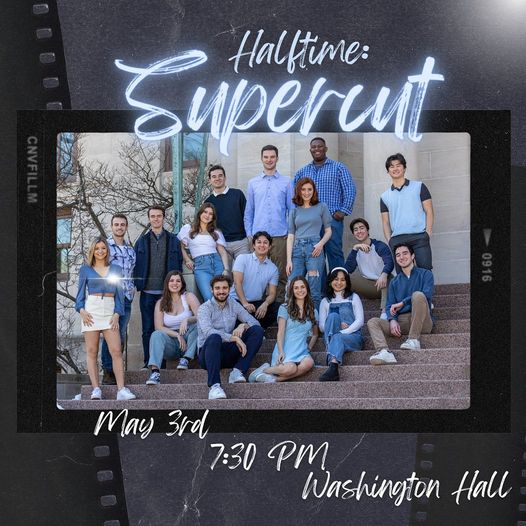The Magical Workings of A Cappella
By: Andrew VanOverbeke
Instruments have become a fundamental part of music. But what happens when you take away the foundation? You get a cappella music! You have probably heard plenty of a cappella music – take this iconic Anna Kendrick cup song scene from Pitch Perfect as an example:
Anna Kendrick isn’t the only one who sings a cappella. J.C. Tolentino remarks about the numerous places where a cappella music is a part of the music world, including religious settings, barbershop groups, and of course, college. Pitch Perfect is a movie centered around collegiate a cappella groups, and while it is very dramatized, the existence of collegiate a cappella groups is very real. Musical historian Joshua Duchan traced the emergence of collegiate a cappella groups in the United States all the way from the first group in Yale to now, and presented it in the graph below:

Among other things covered in his study, it is remarkable to see the huge increase over time. What in the world could cause such a sharp increase? Duchan made some claims about it being an expressive outlet and a close community. To test Duchan’s claims, I interviewed Grace Organ, a member of the University of Notre Dame’s premier co-ed a cappella group, Halftime ND. One of my questions was about how many creative outlets Organ had: “I sing for [my dorm]’s Mass, but other than that Halftime is my primary creative outlet.” Halftime ND meets twice a week for four hours total, according to Organ, which is the perfect amount of time for her to exercise her creative side. There are 17 other members of Halftime ND, all of which could call their group an expressive outlet. There are a few members that are involved in other creative groups (such as Notre Dame’s theater group PEMCo) but in general Halftime ND is the main creative activity. This agrees with the first of Duchan’s claims, but what about the community part? As a first-year student, Organ was able to comment on both felt and perceived community: “I’m pretty new, so for me, it’s [just] a group of friends. I definitely see the bonds of the older members though, and would say that they are closer to family.” This is rather common when it comes to most college clubs, though. As college students put more and more effort into an extracurricular, the relationships between the members of the club grow closer and closer. There are two resulting conclusions: Duchan is not wrong that people join a cappella groups (in part) for the community, but it doesn’t seem to be a unique reason.

Another remark that Organ made was when asked about the feeling of singing and harmonizing with the group. “It’s amazing: there’s nothing like it. There’s something special about creating something beautiful as a group and knowing that a part of you – your very voice – is contributing to that beauty.” Halftime ND performed an excellent concert on May 3rd, and it certainly lived up to Organ’s description.
What makes a cappella music so special, though? How does a cappella reach the status of “amazing,” as Organ describes it? The Calgary Children’s Choir lays out three specifics that outline the benefits of a cappella over singing with instruments. The first of the three is the timbre of the voice. The sound that the voice makes while singing is the most unique sound that is used in music – no other instrument can produce words to a song or the sound of a voice harmonizing with other voices. In addition, the audience gets a much more intimate, human-to-human connection to the music. Another important phenomenon of a cappella sound is overtones. While overtones can be created with instruments, it is often hard to figure out how to overcome the limitations of an instrument. Since singers have full control of their voice as their “instrument,” the overtones generated while singing are clear and exquisite – these additional, extra-intentional sounds add so much; the timbre of rich overtones in the human voice can be heard to the fullest. In fact, the addition of instruments, unfortunately, takes away from the impact that overtones can have while singing a cappella.
Lastly, intonation matters. Similar to overtones, singers have the most control over their voice when it comes to pitch compared to musicians that use instruments. Not only this, but all of the singers in a cappella groups have the ability to adjust their intonation to sound good with their group members. Professor and missionary David M. Howard addressed this in his breakdown of the typical choral singing formation. He acknowledges that the typical expectation of a performance is that they stay in key throughout the duration of an entire song. While most would agree that this is the general expectation, Howard also recognizes that this is not as imperative for a cappella performances. With the foundation of instruments, there is a set key that the ensemble agrees with, but for a cappella ensembles, there is no anchoring instrument. This means that as long as the ensemble starts and continues to stay in the same key relative to the rest of the group, it is still acceptable. In his research, he found that a group that he listened to flattened by a full semitone, which would be horrendous in groups with instruments. Thankfully, though, it was a cappella, so it was okay.

There is another, unexpected aspect to a cappella music: gender. The most famous a cappella group, Pentatonix, is made up of 5 members: a soprano, tenor, baritone, bass, and percussion/bass. Unsurprisingly, the soprano is the only female member of the group.
Something that is special about this group, though, is that the “tenor” has the same vocal range as the soprano. This would not be uncommon many years ago when there were not as many societal implications in part assignments, but nowadays, this is quite uncommon, and it raises the question of modern gender identity in relation to a cappella groups. Grade school choir teacher Stephanie Trump talks about gender identity in relation to singing voices in unusual cases. Through an interview with a transgender student (alto, male) and a gender non-conforming student (tenor/alto), Trump provides some insight into their thoughts. The first student, who is a member of the women’s choir, and the second student who couldn’t fit in with either the men’s or women’s choir, both felt out of place in the singing community. This issue is not unique to these two students – irregular voices (like the one in Pentatonix) have always been present in singing. It presents both a unique opportunity for these singers to stand out, but also a challenge that they are irregularities in the singing community.
Overall, these are some of the features that make a cappella music so awe-inducing, all the way from collegiate to professional. The things that singers can do and the unique styling that the lack of instruments can give both make this type of music uniquely excellent. So now, when you listen to a cappella music, I hope you remember not just how amazing it is but also why!